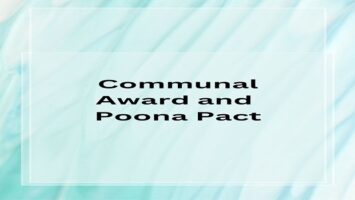Causes For The Rise Of Extremism:
The causes for the rise of extremists or militant nationalism are very much the same as those responsible for the rise of nationalism in India. Leaders like – Tilak, Ashwini Kumar Dutt, etc. had been active to propagate militant nationalism since the beginning. The leadership of the Swadeshi Movement transferred from moderates to extremists like Bipin Chandra Pal, Aurobindo Ghosh, Tilak, etc. It was due to many factors–
(1) The Indian Council Act 1892 did not satisfy the aspirations of even the Moderates. It was contended that the policy of appeals and prayers had brought forth no result. The Government of India considered that policy as a sign of weakness. To quote Tilak, “Political rights will have to be fought for. The Moderates think that these can be won by persuasion. We think that they can only be obtained by strong pressure.”
(2) The constant economic drain on the resources of the country due to foreign domination added to the discontentment in the country. The writings of men like Dinshaw Wacha, R.C.Dutt (Economic History of India), and Dadabhai Naoroji (Poverty and Un-British Rule in India) proved that the impoverishment of the people of India was due largely to the deliberate policy of the British Government. The policy of the Government of India sacrificed the industries of India in the interests of British manufacturers. There seemed to be no prospects for Indian industries.
(3) Circulation of the vernacular newspaper was going up from 2,99,000 in 1885 to 8,17,000 in 1905. Some of the popular Journals like Calcutta Bangabasi (Bengali), Kesari (Marathi), and Kal of Poona opposed the moderate Congress.
(4) The achievements of the Moderates appeared frustrating to the young educated. Opportunities in public services were strictly limited. For example, in 1903 only 16,000 Indians held posts at salaries higher than Rs. 75 a month.
(5) The terrible famines of 1896-97 and 1899-1900 coupled with the Bubonic plague which broke out in Maharashtra took a heavy toll on life. These events revealed to the Indians their plight of utter helplessness. Even recurring famines were attributed to the anti-national policy followed by the Government.
(6) The immediate cause for the rise of extremism was the reactionary rule of Lord Curzon. He passed the Calcutta Corporation Act, (1899) reducing the Indian control of this local body. The Universities Act (1904) reduced the number of elected members in the University bodies. It also reduced the autonomy of the universities and made them government departments. The Sedition Act and the Official Secrets Act reduced the freedoms of all people. His worst measure was the Partition of Bengal (1905).
(7) Some of the great thinkers and leaders like Vivekananda, Tilak, Aurobindo Ghosh, etc. of the period also stirred the people towards the path of extremism. Vivekananda was the first to say openly, “Weakness is sin, weakness is death. When, O Lord, will our nation be free.”
(8) The external events exploding the myth of racial superiority of the whites also helped in the growth of extremism. The emergence of Japan as a modern powerful country after 1868, its victory over Russia in 1905, and similarly the defeat of Italy at the hands of Ethiopia in 1896 proved conclusively that all claims of racial superiority were false. The events in Ireland, Russia, Egypt, Turkey, and China also instilled a new self-confidence in the Indian people.
(9) Though the Indians had helped the British to develop their colonies in South Africa, they were subject to racial discrimination. They were denied the right to vote, to travel in buses and coaches reserved for the Whites, and unfair taxes levied on them. To further demean the Indians, the Registration Act required them to carry identity cards at all times. News of such racial prejudice angered the Radicals, and they were determined to express their opposition.
(10) Long before the launching of the Swadeshi movement as part of the agitation against the partition of Bengal, the seeds of swadeshi had been sown in Bengal by Ashwini Kumar Dutta and Rabindranath Tagore, who repeatedly called for Atma Sakti (self-reliance) through swadeshi enterprise and national education. Similarly in Punjab, the cult of swadeshi was being propagated by Arya Samajists like Lala Lajpat Rai.
(11) The arrest of the Natu Brothers in 1897 and their deportation even without disclosing charges against them infuriated people. In the same year, Tilak and other newspaper editors were sentenced to long sentences for arousing public sentiments.
(12) New leaders on the bloc aroused the self-respect of people and people now find it humiliating to subjugate to alien rule. It led to awareness among the masses too which moderates have ignored by focusing only on the upper-middle class. Vivekananda said – “The only hope of India is from the masses. The upper classes are physically and morally dead”.
(13) The torch of extremism was lit by Tilak who used religious orthodoxy i.e. organization of the Ganesh Festival since 1894 to mobilize people and the Shivaji Festival since 1896 to inspire the youth. He was the first to give the slogan of “Swarajya, Swadeshi and Boycott” and wrote in his paper Kesari, “Our nation is like a tree, of which the original trunk was Swarajya and branches were swadeshi and Boycott”.
(14) The three pillars of extremism were ‘Lal, Bal, and Pal’ (Lala Lajpat Rai, Bal Gangadhar Tilak, and Bipin Chandra Pal) which became the ideals of future nationalists. All of them through their newspapers (Tilak’s Kesari, Pal’s New India, and Lala’s Punjabi) launched vehement attacks on the British government.
- The Morley-Minto Reform or the Indian Council Act 1909
- The Home Rule League, 1916
- Montagu Declaration or August Declaration [1917]
- Montagu-Chelmsford Reforms or the Government of India Act 1919
- Rowlatt Act, 1919
- Jallianwala Bagh Massacre [April 13, 1919]
- The Khilafat Movement, 1919-1920
- The Non-Cooperation Movement (1920-22)
- Simon Commission, 1927
- Gandhi-Irwin Pact: March 5, 1931
- Popular resistance to company rule– NIOS









Comments (No)